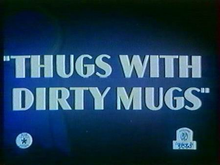Thugs with Dirty Mugs
| Thugs with Dirty Mugs | |
|---|---|
 Title card from the 1944 Blue Ribbon reissue | |
| Directed by | Tex Avery |
| Story by | Jack Miller |
| Produced by | Leon Schlesinger |
| Starring | Tex Avery Mel Blanc John Deering |
| Music by | Carl W. Stalling |
| Animation by | Sidney Sutherland |
| Color process | Technicolor |
| Distributed by | Warner Bros. Pictures The Vitaphone Corporation |
Release date | May 6, 1939 |
Running time | 8:05 |
| Language | English |
Thugs with Dirty Mugs is a 1939 Warner Bros. Merrie Melodies cartoon directed by Tex Avery.[1] The short was released on May 6, 1939.[2]
Title
The title is derived from the Warner Bros.' 1938 acclaimed feature film, Angels with Dirty Faces. It is similar to Avery's later MGM crime/detective-oriented cartoon Who Killed Who?.
Plot
The film takes place in the fictional New York town of Everyville, which is home to a vast total of 112 banks.
The title card and technical credits are followed by introductions of the two lead characters: "F.H.A. (Sherlock) Homes" as police chief "Flat-Foot Flanigan with a Floy Floy," and "Edward G. Robemsome" (a caricature of Edward G. Robinson) as notorious gang leader "Killer Diller." After these introductions, Killer and his gang are seen robbing every bank in the town in numerical order (except that they skip the 13th bank out of superstition) — with the newspaper Telegraph Post reporting the criminals' every move, and even declaring that they have robbed 87 banks in a single day. Despite the criminals' predictability and their endless sight gags (in which Killer does everything from causing one bank to behave like a casino machine to picking up a pay phone and inserting his gun into the speaker, resulting in the operator shrieking in terror and giving him lots of coins), the police are unable to arrest them. However, after so much bafflement, Flanigan himself gets help from an unlikely source: a man in the front of the theatre who had been sitting through the whole picture; he tells him that Killer is making plans to go to the estate of Mrs. Lotta Jewels at 10:00 in the evening. While Killer and his gang are spending time in said estate, listening to "The Lone Stranger" on radio, Flanigan and his men find the criminals and fire at them. Thus, Killer is captured, convicted, and given a long sentence — which is revealed to be a prison term in which he must write standards ("I've been a naughty boy") on a blackboard one thousand times, much like schoolkids of that era. The imprisoned Killer blows a raspberry as the cartoon irises out.
Notes
The cartoon was banned in Winnipeg, Manitoba in 1939, because censors "felt the film was just an excuse to show criminal activity."[3]
DVD release
- Thugs with Dirty Mugs is presented uncut and restored on the Looney Tunes Golden Collection: Volume 3.
See also
References
- ^ Beck, Jerry; Friedwald, Will (1989). Looney Tunes and Merrie Melodies: A Complete Illustrated Guide to the Warner Bros. Cartoons. New York, NY: Henry Holt and Company. p. 87. ISBN 0-8050-0894-2.
- ^ Lenburg, Jeff (1999). The Encyclopedia of Animated Cartoons. Checkmark Books. pp. 104–106. ISBN 0-8160-3831-7. Retrieved 6 June 2020.
- ^ Forbidden Animation: Censored Cartoons and Blacklisted Animators in America by Karl F. Cohen — Google Boeken
